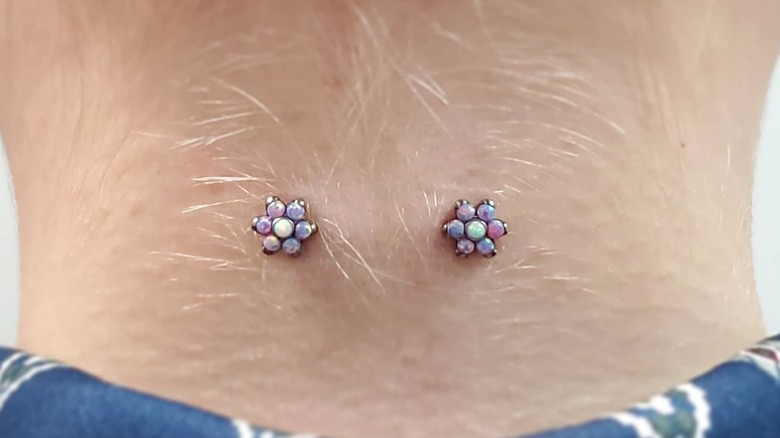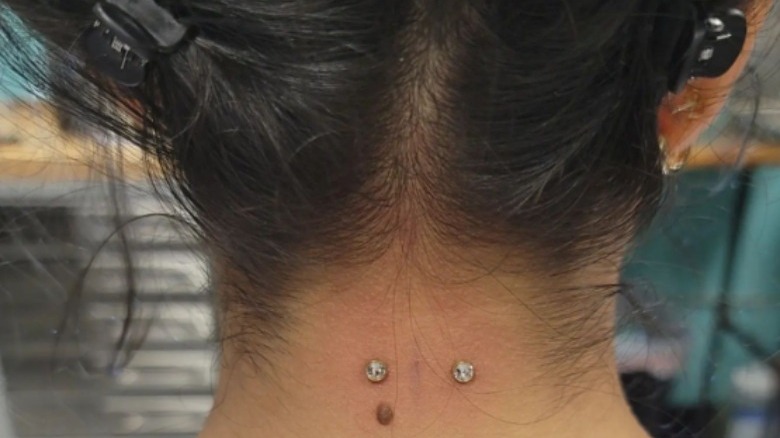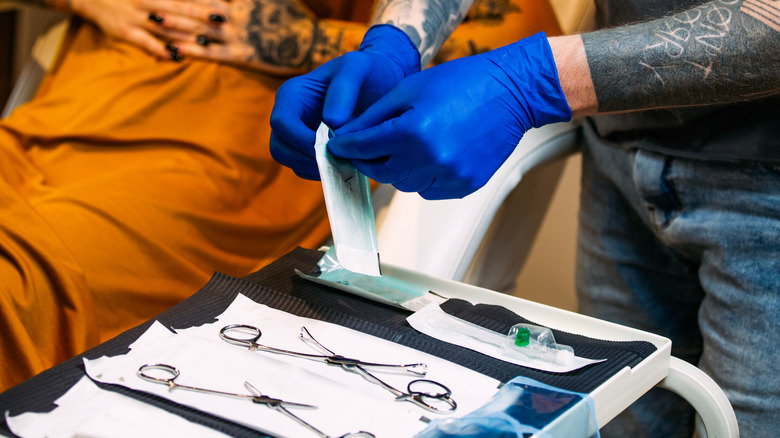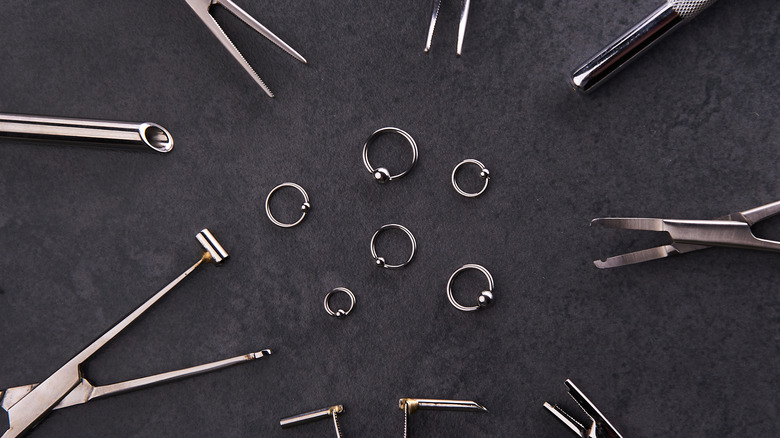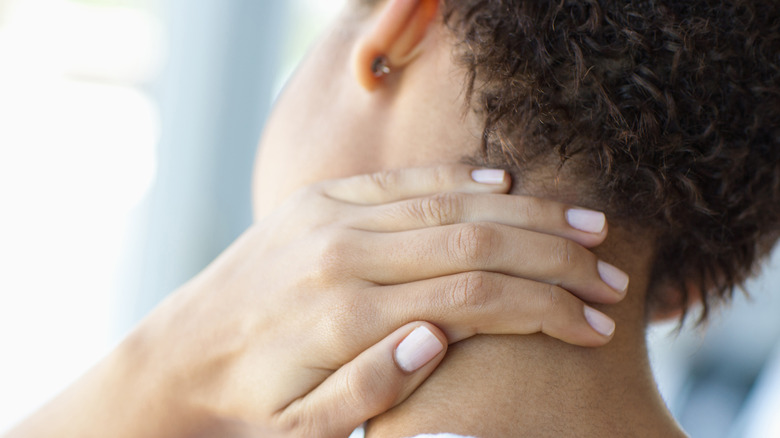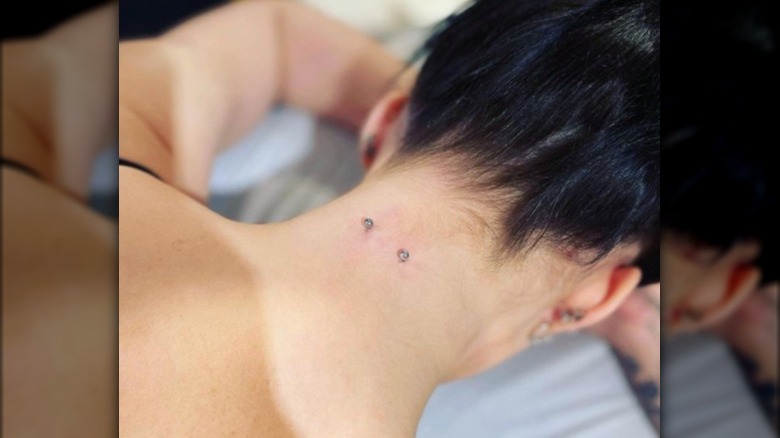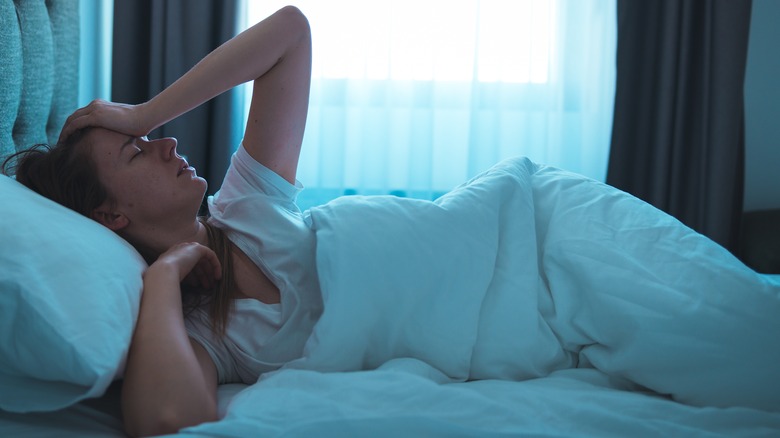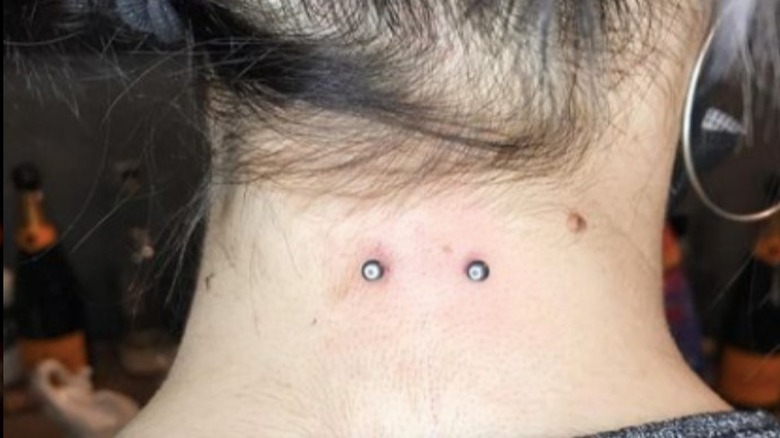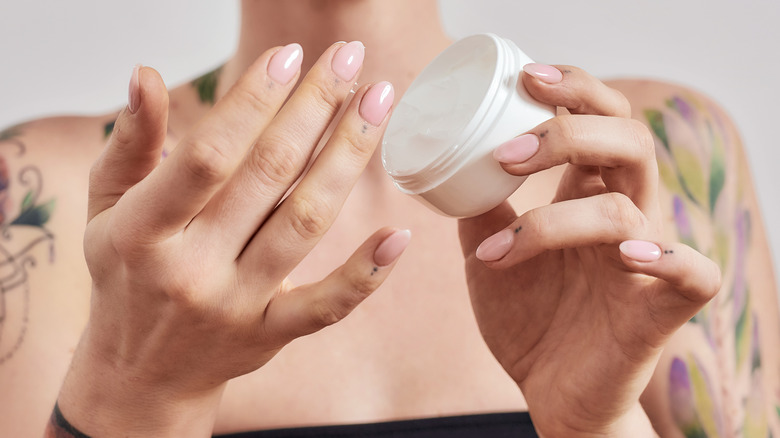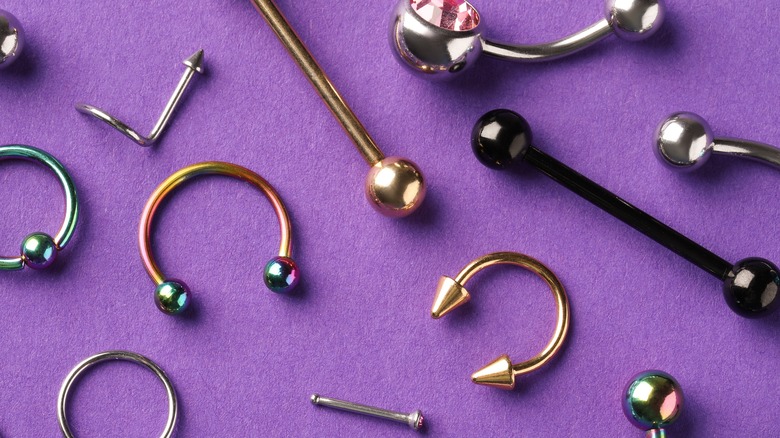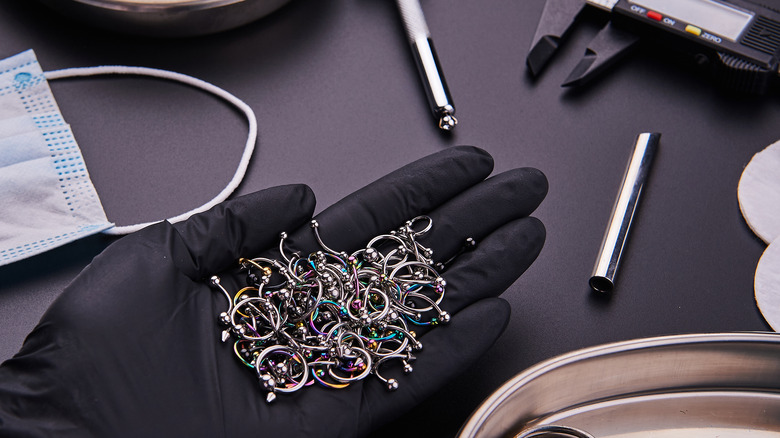Everything You Need To Know Before Getting A Nape Piercing
The reasons individuals are drawn to body piercings will vary, but they often include self-expression. Unlike tattooing, the art of piercing is less permanent, which appeals to those who like to regularly change their appearance. If the standard approach to piercing on the earlobes no longer appeals to you, then perhaps it is time to try something different. What better option to set yourself apart, show your individuality, and decorate your body than with a more uncommon piercing choice? This is where we introduce you to the nape piercing, a surface piercing created on the back of the neck.
Piercings and other body modifications allow individuals to express themselves and explore their personal identities. Nape piercing is gaining in popularity because it offers something new and exciting. Although the process and the pain experienced are more intense than something simple like getting your ears pierced, this option is effortlessly cool and unique.
It is also interesting to note that despite qualified piercers having performed surface piercing multiple times, they are not all that common. According to HuffPost, a 2016 study indicated that only 14% of individuals will try piercings that are not on the ear lobe. Will you be one of them? Being armed with the right knowledge about what a nape piercing is and the steps involved in getting it done can help you decide whether you want to get your own — or avoid the area entirely.
What is a nape piercing?
A nape piercing is a surface piercing on the back of the neck, just below the hairline. They can sometimes be referred to as neck piercings, although this is a more generalized term used to describe one of several piercings in the area. Unlike dermal piercings, nape piercings are most commonly created with a surface bar and have an entry and exit point.
The piercing can be worn horizontally or vertically (and the jewelry you choose will impact this). It offers the wearer something different and is ideal for those who want to experiment with body modification. It can also be appealing because the location is not immediately visible and can be easily covered by your clothing or hair. Those who work in conservative environments and may not otherwise be able to wear piercings will find this placement a welcome alternative. Unfortunately, the nape piercing is not without complications, and getting pierced here can have some drawbacks.
How are nape piercings done?
The art of piercing can become almost addictive. There is even a word, stigmatophilia, to describe those who find body modification particularly attractive. However, body piercing is nothing new, and it is a much older practice than many of us even realize. For example, the mummified remains of Ötzi, which were discovered in 1991 in the Ötztal Alps between Italy and Austria, were found to have pierced ears (via BestLife). He is believed to have died over 5,000 years ago, and you don't need us to tell you that's a really, really long time.
Nape piercings involve a different approach than piercing the standard ear lobe, but the way the bar is inserted and the preparation for nape piercings is not dissimilar to that of a belly piercing. The jewelry will enter one hole and exit through another (this is also different from a dermal piercing with no exit point). "The area is prepped with a surgical scrub or soap and marked with the placement," professional piercer Elayne Angel tells PopSugar. "The piercer will either use forceps or their fingers to secure the tissue; then, they make the piercing with a sterile, disposable needle." When this process is complete, the jewelry will be inserted.
Are nape piercings considered safe?
A nape piercing is done on the back of the neck, and because of the location, there is a potentially higher risk of infection. If done incorrectly, there could be damage to the surrounding tissue and nerves, and even scarring. This may sound off-putting, but it is a piercing that skilled professionals regularly do.
Professional piercer Elayne Angel shared some of the complications to consider with PopSugar. "If a nape piercing is done too deep, there is a risk of damaging nerves, including the spinal accessory nerve (responsible for muscle function) and cutaneous nerves (responsible for scalp sensation)," Angel explains. "Additionally, there are numerous planes of fascia (connective tissue) below the surface that could potentially carry infection to other areas of the body. Therefore, it is vital that you go to a qualified professional piercer."
Finding the right piercer should be an important step in preparing for your nape piercing. You should ask them any questions and concerns you have beforehand, which can make you feel more comfortable about the entire process. Maria Tash, who owns and operates a piercing business, revealed to HuffPost how seeking an experienced and skilled piercer is vital because piercings cannot be done by just anyone. "There's an art to piercing, to do it well," she explained. "The truth is, to do it well is a lot more complicated." You don't want to risk getting it wrong with something as uncommon and potentially complicated as a nape piercing.
How painful is a nape piercing, and what are the drawbacks?
Nape piercings look great, but are you concerned about the potential pain involved? How painful a nape piercing is will vary depending on your pain threshold. While it will hurt more than an earlobe piercing, which does not have a high concentration of nerves, many do not consider it excruciating. However, it seems even professionals cannot agree on just how much pain you will experience.
"On a scale from 1 to 10, the initial piercing pain ranges between a hard 6 and 8," piercer Natalia Smith tells Byrdie. In contrast, professional piercer Elayne Angel tells PopSugar, "Most of the clients I performed them on described the procedure as a pressure sensation and not particularly painful. It is definitely not the most sensitive spot on the body that gets pierced."
Another factor that could influence the pain experienced with a nape piercing is the healing time. The main drawback is the length of healing, which can take anywhere from six to nine months to fully heal. Although nape piercings are considered safe for the general public, there are some people who are reported to be more at risk than others. According to a HuffPost article by Glenn D. Braunstein, M.D., those who should avoid piercings include pregnant women, individuals who are immuno-compromised or suffering from specific heart conditions, and those taking anticoagulants.
How expensive is a nape piercing?
The cost for your piercing will vary depending on the piercer and studio you choose, and it is essential to do your research beforehand to find someone reputable. You are likely looking to pay a minimum of around $50, according to Healthline. Some shops will charge more for jewelry, and others may expect a tip for their services, so it is important to discuss expectations beforehand. (We always recommend tipping for both tattoos and piercings.)
"Pricing of the jewelry costs could always be even more depending on the type of material, style, and brand of the threaded ends chosen for use," piercer Drew Young tells Byrdie. Although you may be tempted to spend less money on getting a piercing done by choosing one of the less reputable studios, quality is not something you should ever sacrifice. The importance of using a skilled piercer cannot be stressed enough, and it could directly impact your healing. According to TatRing, a lot of piercings on the skin's surface don't take, and this is because inexperienced piercers are doing them. Without a proper understanding of the body, the piercing will never truly last. This brings us to our next point, which is why surface piercings are notorious for their high rate of rejection.
Why do nape piercings have a high rate of rejection?
Surface piercings, like the nape, are often rejected by the body because they are done close to the skin's surface. Dermatologist Angelo Landriscina expands on this point, telling Health, "Any time a foreign body, such as a piercing, is introduced into the skin, there will be inflammation."
But how do you know if your piercing could be experiencing rejection? "In the case of piercing rejection, that inflammation actually starts to move the piercing toward the skin surface and can even cause it to perforate out of the skin," Dr. Landriscina explains. It is essential to look out for any signs of infection, which could include redness, swelling, and discharge from the piercing site (via Medical News Today). This could also be accompanied by a fever.
While it can be disheartening to have to remove the piercing, Dr. Landriscina notes that this is the best course of action, saying, "If one of my patients was having a piercing rejected, I'd tell them to remove the piercing as soon as possible rather than letting it fall out on its own," before adding, "Allowing the inflammation around the piercing to carry on can result in unsightly scarring."
Can you sleep on your back after a nape piercing?
Until healed, a piercing is an open wound that you should treat with care, which means taking things like your sleeping habits into consideration. The location of your new piercing could impact how you sleep in the weeks or months after getting it done.
If you are a back sleeper, you may find yourself having to change your sleeping position after getting a nape piercing. This is because you want to avoid causing irritation and increasing your own discomfort. Spoiler alert: if you don't take this advice you're likely to endure more than a few sleepless nights.
As a reminder, the nape is located on the back of the neck, and sleeping on your stomach or side will be beneficial in this instance. This is to avoid putting pressure on the area, which would cause pain, as well as reduce the risk of rejection and infection (via Skin Artists). For this reason, it is best to wait until the nape piercing has fully healed before sleeping on your back.
Does having long hair affect your nape piercing?
Before getting your piercing, the area will be prepped and excess hair will be shaved so there is a clean surface for the piercer to do their work and to minimize infection. If you have long hair this is yet another thing to take into consideration before deciding on a nape piercing. While it is not a deal-breaker, and many women with long hair do get pierced in this location, it will make caring for the nape piercing more challenging. This is because the hair can easily wrap around the piercing and could result in the jewelry falling off and will cause bleeding (via Skin Artists).
The solution is simple; tie up your hair for the duration of the healing time to avoid any added discomfort and to prevent the increased risk of rejection. The location of the piercing is also prone to get caught on clothing, so take care when dressing. Any complications are more likely to result in damage while the piercing is still new and healing (via Body Jewellery Shop).
Caring for a nape piercing
Nape piercings need to have proper aftercare to prevent the risk of infection. Aftercare should include using the right products to clean the area at least once, but preferably twice, a day, with a saline solution and a cotton swab. However, overcleaning can cause more harm than good, resulting in irritation and dryness (via Dr. Piercing).
It may seem like common knowledge, but always wash your hands thoroughly before touching the piercing. There are also harsh chemicals that you want to avoid, including alcohol, hydrogen peroxide, and iodine (when making a saline solution it is recommended not to use iodized salt). It is important to keep the skin hydrated and the piercing away from dirt. Unless you are cleaning it, it is best to completely avoid touching the piercing as playing with it can introduce bacteria, leading to an increased risk of infection or other complications.
What jewelry is best when deciding on your nape piercing?
The right jewelry for your nape piercing is essential as it can prevent the risk of rejection and infections. A nape piercing can be created with a surface anchor or a surface bar, which is the most commonly used jewelry for horizontal piercings (via Urban Body Jewelry). The appeal of the surface bar is that it's tough and resistant.
Unlike the surface bar, the surface anchor does not have an entry and exit point, and although it is not as durable (and more likely to snag on things), it does offer you more versatility. This is an excellent option if you want to experiment with the placement, for example, wearing the nape piercing at a vertical angle. You may be tempted to change out your piercing from the original to something you consider more fashionable, but you will need to be patient and wait until it is fully healed. The result of removing jewelry too early can irritate the area and increase your discomfort.
Why some metals used in nape piercing jewelry are superior to others
When it comes to piercing jewelry, there is no one option to suit all. There are also some metals that are considered safer than others and will reduce the rate of infection/rejection. For example, Dr. Piercing notes that nickel, although cheap and readily available, is more likely to result in an allergic reaction.
This is why implant-grade titanium, surgical steel, and 14-karat gold are often better choices. Surgical steel is a popular choice for body jewelry because it is durable, hypoallergenic, and affordable. Titanium, although often more expensive than other metals, is recommended, especially if you do not intend to regularly change your jewelry.
"When [titanium] comes from a reputable company, it is high polish and hypoallergenic, which can make healing a new piercing a breeze. Titanium handles moisture well and is very body safe for the long-term wear body piercings require," professional piercer Cozmo Faris explains to Byrdie. For those wanting a more affordable metal, niobium could be a good alternative. According to Pierce of Art, it is hypoallergenic and free from nickel, as well as not likely to corrode.
How can you get in the zone when getting a piercing?
Getting a new piercing can be an exciting experience. Still, if your chosen location differs from the norm or involves a more complicated procedure, you can be anxious. If you feel nervous before the nape piercing, you may consider bringing a friend with you for your support, but you should think twice before doing this. The process can be much calmer when someone arrives at the piercing studio alone.
"People transmit nervous energy onto their friends, so sometimes it's better to be alone," professional piercer J. Colby Smith from New York Adorned told Teen Vogue. "It's easier for me to connect with my clients and keep their energy under control if they're on their own." But the support system you choose is not necessarily the most important step in this process, as Smith explained that it's "all about your mental state" and stressed the importance of eating and sleeping well before your appointment.
The good news? Once you have one piercing, you may be inspired to get multiple, and you would not be alone in your decision. "After conquering the anxiety of successfully receiving and healing that first body piercing, it becomes more exciting to choose the next one," professional piercer Stephanie Hutter-Thomas tells Refinery29. "The more exposure we have to a particular chosen event or stimuli, the less frightening or outrageous it seems because we slowly become desensitized." So, with all of this information, how are you feeling about nape piercings?
